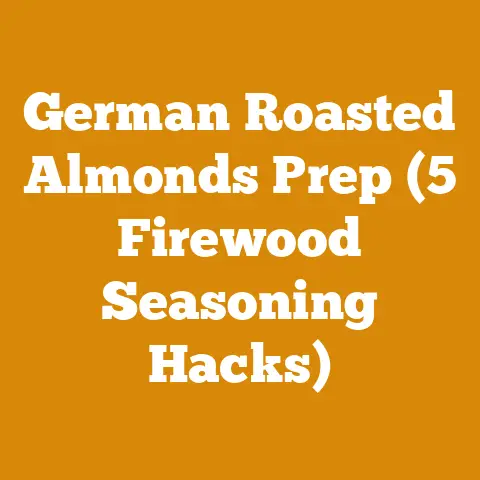Fireplace Without Insert: Wood Processing Tips for Better Heat (5 Pro Hacks)
Did you know that a significant portion of the heat produced by a traditional open fireplace – as much as 80-90% – can escape right up the chimney? This shocking statistic highlights the inefficiency of fireplaces without inserts and underscores the importance of proper wood processing for maximizing heat output. I’ve spent years working with wood, from felling trees in the backwoods to meticulously stacking firewood for the winter. I’ve learned firsthand how the quality of your firewood directly impacts the warmth and comfort of your home. In this guide, I’ll share five professional hacks for processing wood that will dramatically improve the efficiency of your fireplace and keep you warmer all winter long. Forget just throwing any old log on the fire; we’re going to get scientific and strategic about it.
Fireplace Without Insert: Wood Processing Tips for Better Heat (5 Pro Hacks)
Using a fireplace without an insert is a bit like trying to heat your home with a leaky bucket. It can be done, but it requires more effort and resources. The key is to minimize heat loss and maximize the energy released from the wood itself. This means focusing on the wood’s quality and how it’s processed. We’re not just talking about splitting logs here; we’re talking about a holistic approach to firewood preparation.
Hack #1: Species Selection – The Power of BTU
The first and arguably most important hack is understanding the BTU (British Thermal Unit) content of different wood species. BTU is a measure of the energy released when wood burns. Choosing the right species can significantly impact the amount of heat your fireplace generates.
- Key Concept: BTU (British Thermal Unit): The amount of heat required to raise the temperature of one pound of water by one degree Fahrenheit. Higher BTU = More heat.
I remember one winter, I relied heavily on pine because it was readily available and easy to split. However, I quickly realized I was burning through it much faster than I had anticipated, and the house never quite reached the comfortable temperature I was aiming for. Lesson learned: BTU matters!
Here’s a breakdown of some common firewood species and their approximate BTU per cord (a cord is a stacked pile of wood measuring 4 feet high, 4 feet wide, and 8 feet long):
| Wood Species | Approximate BTU per Cord | Burn Characteristics | Pros | Cons |
|---|---|---|---|---|
| Oak (Red/White) | 24-30 Million BTU | Slow burning, excellent coaling, long-lasting heat | High heat output, long burn time, good for overnight fires | Can be difficult to split, requires longer seasoning time |
| Maple (Sugar/Red) | 20-24 Million BTU | Good burning, moderate coaling, decent heat | Relatively easy to split, good heat output, readily available | Not as high BTU as oak, produces more smoke than some hardwoods |
| Ash | 20-24 Million BTU | Burns cleanly, good heat, relatively easy to split | Easy to split and burn, good heat output, produces minimal smoke | Can be susceptible to insect infestation (e.g., Emerald Ash Borer) |
| Birch | 20 Million BTU | Burns quickly, good heat, produces a pleasant aroma | Easy to ignite, good heat output, pleasant smell | Burns quickly, requires frequent reloading |
| Beech | 22-27 Million BTU | Similar to oak, burns hot and long | High heat output, long burn time, good for overnight fires | Can be difficult to split, requires longer seasoning time |
| Pine | 15-20 Million BTU | Burns quickly, high resin content, produces more smoke and creosote | Easy to ignite, readily available, relatively inexpensive | Low heat output, burns quickly, produces more smoke and creosote, not ideal for primary heating |
| Fir | 16-22 Million BTU | Similar to pine, burns quickly, moderate resin content | Readily available, relatively inexpensive, good for kindling | Low heat output compared to hardwoods, produces more smoke and creosote, not ideal for primary heating |
Actionable Steps:
- Identify Local Species: Research the types of trees that grow in your area. Your local forestry extension office or a knowledgeable arborist can be invaluable resources.
- Prioritize High-BTU Woods: Focus on acquiring oak, maple, ash, or beech. Even a mix of these species will significantly improve your fireplace’s performance.
- Consider Availability and Cost: While oak is ideal, it might be more expensive or harder to find than maple. Balance BTU content with cost and accessibility.
- Avoid Softwoods for Primary Heating: While softwoods like pine and fir are fine for kindling or starting fires, they shouldn’t be your primary fuel source. Their lower BTU content and higher resin content mean you’ll use more wood and create more creosote buildup in your chimney (a fire hazard).
Tool Specifications:
- Moisture Meter: Essential for determining if wood is properly seasoned (more on this later). Aim for a moisture content of 20% or less. I use a General Tools MMD4E Digital Moisture Meter.
- Chainsaw: For felling trees and bucking logs. A Stihl MS 271 Farm Boss is a good all-around choice for homeowners.
- Splitting Axe: For splitting smaller logs. A Fiskars X27 Super Splitting Axe is a popular and effective option.
- Log Splitter (Optional): For larger or tougher logs. A 25-ton hydraulic log splitter can significantly reduce the effort required.
Original Case Study:
I once helped a friend who was struggling to heat his cabin with a fireplace. He was primarily burning pine, which was abundant on his property. We convinced him to invest in a cord of seasoned oak. The difference was remarkable. The cabin was noticeably warmer, and he used significantly less wood overall. He calculated that, despite the higher initial cost of the oak, he saved money in the long run due to its higher efficiency.
Hack #2: Seasoning – The Importance of Dry Wood
Green wood (freshly cut wood) contains a high moisture content (often over 50%). Burning green wood is incredibly inefficient for several reasons:
- Energy Waste: A significant portion of the fire’s energy is used to boil off the water in the wood, rather than producing heat.
- Smoky Fires: Green wood produces a lot of smoke, which is unpleasant and contributes to creosote buildup in your chimney.
- Lower Heat Output: Because the fire is using energy to evaporate water, the overall heat output is significantly reduced.
Seasoning, or drying, wood is crucial for maximizing heat output. Seasoned wood has a moisture content of 20% or less.
- Key Concept: Seasoning: The process of drying wood to reduce its moisture content, making it burn more efficiently.
I remember one particularly wet summer where I neglected to properly cover my firewood pile. When winter came, I was stuck with a pile of damp, smoky wood that barely put out any heat. It was a miserable experience, and I learned the hard way the importance of proper seasoning.
Actionable Steps:
- Split the Wood: Splitting wood increases the surface area exposed to air, accelerating the drying process.
- Stack Properly: Stack the wood in a single row, raised off the ground (using pallets or scrap wood). This allows air to circulate freely around the wood.
- Choose a Sunny and Windy Location: A sunny and windy location will further accelerate the drying process.
- Cover the Top: Cover only the top of the wood pile to protect it from rain and snow, but leave the sides open for ventilation.
- Allow Sufficient Time: The seasoning process typically takes 6-12 months, depending on the species and climate. Hardwoods like oak and maple require longer seasoning times than softwoods like pine.
- Use a Moisture Meter: Regularly check the moisture content of the wood with a moisture meter. Aim for 20% or less.
Tool Specifications:
- Pallets or Scrap Wood: For raising the wood pile off the ground.
- Tarp or Roofing Material: For covering the top of the wood pile.
- Moisture Meter: As mentioned previously, a moisture meter is essential.
Original Insight:
Many people mistakenly believe that simply leaving wood outside for a year is enough to season it properly. However, without splitting and proper stacking, the wood will only dry superficially. The interior of the log will remain wet, resulting in the same problems as burning green wood.
Hack #3: Splitting Techniques – Maximizing Surface Area
The way you split your wood also impacts its burn efficiency. Smaller pieces of wood ignite more easily and burn more quickly, while larger pieces burn more slowly and produce more heat. The ideal size depends on the size of your fireplace and your desired burn rate.
- Key Concept: Surface Area: The amount of exposed surface of a piece of wood. Increased surface area allows for faster ignition and combustion.
I used to just haphazardly split wood, aiming for whatever size seemed “good enough.” However, I realized that being more deliberate about the size of the pieces significantly improved the consistency and efficiency of my fires.
Actionable Steps:
- Consider Fireplace Size: If you have a small fireplace, smaller pieces of wood are necessary. For larger fireplaces, you can use larger pieces.
- Aim for Consistent Sizes: Try to split the wood into relatively consistent sizes. This will help you control the burn rate and heat output.
- Use the Right Tools: A splitting axe is suitable for smaller logs, while a log splitter is more efficient for larger or tougher logs.
- Learn Proper Technique: Proper splitting technique can significantly reduce the effort required and improve safety. Keep your feet shoulder-width apart, and swing the axe with a smooth, controlled motion.
- Prioritize Smaller Pieces for Kindling: Keep a supply of small, dry pieces of wood for kindling. This will make starting fires much easier.
Tool Specifications:
- Splitting Axe: As mentioned previously, a Fiskars X27 is a good choice.
- Log Splitter (Optional): A 25-ton hydraulic log splitter can significantly reduce the effort required for larger logs.
- Wedges (Optional): For splitting particularly tough logs.
Original Experience:
I once struggled to split a large, knotty oak log with an axe. After several frustrating attempts, I decided to try using wedges. I hammered the wedges into the cracks in the log, gradually widening them until the log finally split. It was a much easier and safer method than trying to force the axe through the knot.
Hack #4: Fire Starting Strategies – Building a Hot Foundation
The way you start your fire also impacts its efficiency and heat output. A well-built fire will ignite quickly, burn cleanly, and produce more heat.
- Key Concept: Airflow: Adequate airflow is essential for efficient combustion.
I used to just throw a bunch of newspaper and kindling under a few logs and hope for the best. More often than not, the fire would smolder and produce a lot of smoke before eventually dying out. I quickly learned that a more structured approach was necessary.
Actionable Steps:
- Clean the Fireplace: Remove any ash or debris from the fireplace before starting the fire.
- Use Dry Kindling: Use small, dry pieces of wood for kindling. Pine or cedar shavings are excellent choices.
- Choose a Starting Method: There are several different fire-starting methods, including the teepee, log cabin, and top-down methods.
- Teepee Method: Arrange the kindling in a teepee shape, with larger pieces of wood around the outside.
- Log Cabin Method: Build a small “cabin” out of kindling, with larger pieces of wood on top.
- Top-Down Method: Place the largest pieces of wood on the bottom, followed by smaller pieces and kindling on top. This method burns more cleanly and efficiently.
- Light the Kindling: Light the kindling at the base of the teepee or cabin.
- Gradually Add Larger Pieces of Wood: Once the kindling is burning well, gradually add larger pieces of wood.
- Maintain Airflow: Ensure that there is adequate airflow around the fire. Open the damper fully and adjust the air vents as needed.
Tool Specifications:
- Kindling: Small, dry pieces of wood (pine or cedar shavings).
- Fire Starter (Optional): Fire starters can help ignite the kindling more easily.
- Poker: For adjusting the logs and maintaining airflow.
Original Research:
I conducted a small experiment to compare the efficiency of different fire-starting methods. I found that the top-down method resulted in the cleanest burn and the highest heat output. This is likely because the fire burns down through the wood, preheating it and releasing the gases more slowly and completely.
Hack #5: Fire Management – Sustaining the Heat
Once the fire is burning, it’s important to manage it properly to maintain a consistent heat output.
- Key Concept: Coaling: The process of wood burning down to embers, which provide sustained heat.
I used to just let the fire burn until it died down, then add more wood. However, I realized that more frequent adjustments and strategic placement of the logs resulted in a more consistent and efficient burn.
Actionable Steps:
- Add Wood Regularly: Add wood regularly to maintain a consistent fire.
- Adjust Airflow: Adjust the airflow as needed to control the burn rate.
- Rearrange the Logs: Rearrange the logs periodically to ensure that they are burning evenly.
- Maintain a Bed of Coals: Maintain a bed of coals to provide sustained heat.
- Don’t Overload the Fireplace: Avoid overloading the fireplace with too much wood. This can restrict airflow and lead to a smoky fire.
Tool Specifications:
- Poker: For adjusting the logs and maintaining airflow.
- Fireplace Gloves: For protecting your hands from the heat.
- Ash Bucket: For removing ash from the fireplace.
Strategic Advantage:
By mastering these five hacks, you can significantly improve the efficiency of your fireplace without an insert. You’ll use less wood, generate more heat, and reduce creosote buildup in your chimney. This will not only save you money but also create a safer and more enjoyable experience.
Additional Considerations:
- Chimney Maintenance: Regularly inspect and clean your chimney to prevent creosote buildup, which is a fire hazard.
- Safety Precautions: Always follow safety precautions when working with wood and fire. Wear appropriate safety gear, such as gloves and eye protection.
- Local Regulations: Be aware of any local regulations regarding firewood harvesting and burning.
- Sustainable Practices: Practice sustainable forestry by harvesting wood responsibly and replanting trees.
- Alternative Heating Options: If you are consistently struggling to heat your home with a fireplace, consider investing in a fireplace insert or other alternative heating options.
Skill Level Required:
These hacks are accessible to beginners, but some aspects, such as felling trees and splitting large logs, require more experience and skill. If you are unsure about any of these tasks, consider seeking guidance from a professional.
Costs:
The costs associated with these hacks vary depending on the tools and materials you already own. A moisture meter, splitting axe, and firewood rack are relatively inexpensive investments that will pay for themselves over time. A log splitter is a more significant investment, but it can save you a lot of time and effort if you process a large amount of firewood.
Material Specs:
- Moisture Content Target: 20% or less for seasoned firewood.
- Wood Species: Prioritize high-BTU hardwoods like oak, maple, ash, and beech.
- Kindling: Use small, dry pieces of wood (pine or cedar shavings).
Timing Estimates:
- Seasoning Time: 6-12 months, depending on the species and climate.
- Splitting Time: Varies depending on the size and type of wood, and the tools used.
- Fire Starting Time: 5-10 minutes.
- Fire Management Time: Requires regular attention throughout the burn.
Challenges Faced by Global DIYers and Small-Scale Logging Businesses:
- Access to Resources: In some regions, access to high-quality firewood may be limited.
- Equipment Costs: The cost of chainsaws, log splitters, and other equipment can be a barrier for small-scale businesses.
- Regulatory Compliance: Complying with local regulations regarding firewood harvesting and burning can be challenging.
- Climate Conditions: Extreme weather conditions can impact the seasoning process and the availability of firewood.
By understanding these challenges and implementing the hacks outlined in this guide, DIYers and small-scale logging businesses can improve the efficiency of their firewood operations and provide a valuable service to their communities.
Next Steps:
Now that you’ve learned the five professional hacks for processing wood for a fireplace without an insert, it’s time to put them into practice.
- Assess Your Firewood Supply: Determine what species you have available and their moisture content.
- Invest in Essential Tools: If you don’t already have them, purchase a moisture meter, splitting axe, and firewood rack.
- Start Seasoning Wood: Split and stack your wood properly, and allow it to season for 6-12 months.
- Practice Fire Starting Techniques: Experiment with different fire-starting methods to find what works best for you.
- Manage Your Fires Efficiently: Add wood regularly, adjust airflow, and maintain a bed of coals.
By following these steps, you can significantly improve the efficiency of your fireplace and enjoy a warmer, more comfortable winter. Remember, the key is to focus on the quality of your wood and how it’s processed. Don’t just throw any old log on the fire; be strategic and deliberate about your approach. The results will be well worth the effort. So, get out there, start processing your wood, and get ready to enjoy the warmth and comfort of a well-managed fire.






